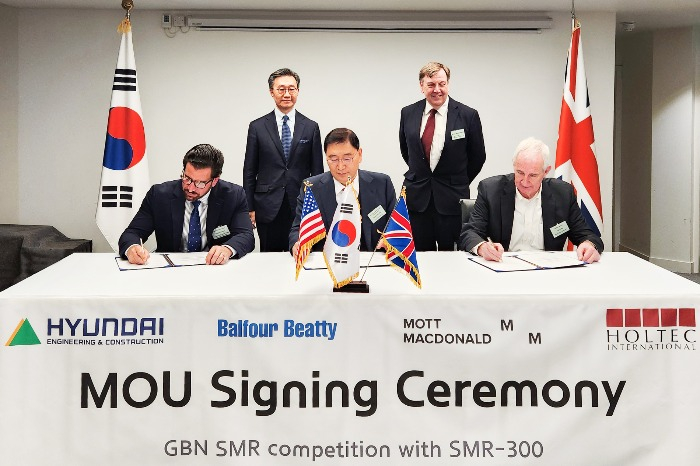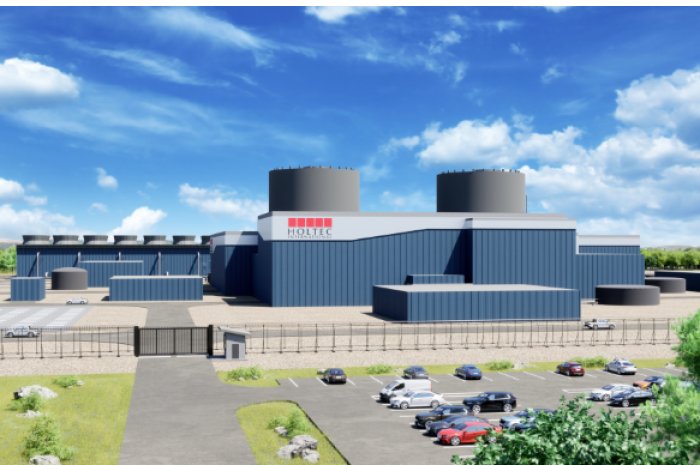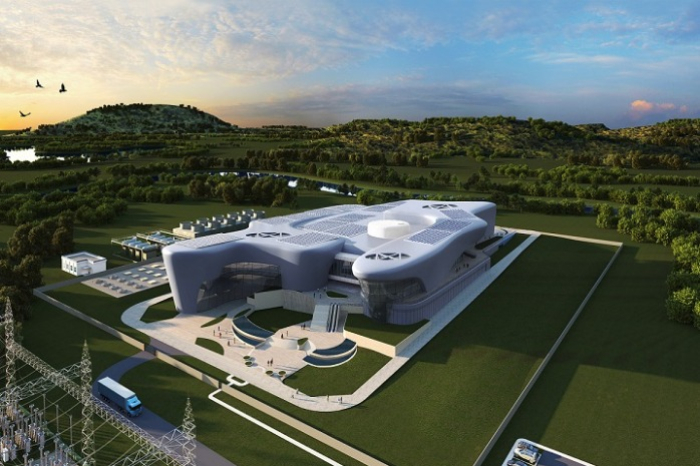Energy
Hyundai E&C expands foreign alliances in pursuit of UK SMR project
Eyeing a UK state project to install SMRs starting in 2030, the Korean company has teamed up with Holtec, Balfour Beatty and Mott MacDonald
By Mar 06, 2024 (Gmt+09:00)
3
Min read
Most Read
MBK’s Korea Zinc takeover attempt to spur search for white knights


Korea Zinc, MBK face proxy war for zinc smelter


Korea Zinc shares skyrocket after buybacks in tender offer


Lotte to liquidate rubber JV in Malaysia, sell overseas assets for $1 bn


Samsung to unveil 400-layer bonding vertical NAND for AI servers by 2026



Hyundai Engineering & Construction Co. (Hyundai E&C) has welcomed two British companies to its joint bid with US energy technology company Holtec International Corp. for a contract to build advanced small modular reactors (SMRs) in the UK in hopes of deploying the first batch in 2030.
The engineering unit of South Korea’s Hyundai Motor Group announced on Wednesday it signed an MOU on Tuesday with Holtec, Balfour Beatty plc and The Mott MacDonald Group to cooperate on advancing to the next phase of the British government’s SMR competition. The initiative is being overseen by Great British Nuclear (GBN), a UK government-backed entity set up to deliver nuclear projects in Britain.
In October, Hyundai E&C and Holtec joined the shortlist of six contenders bidding for the UK SMR project under the name of Team Holtec.
The Hyundai E&C and Holtec consortium’s SMR design faces challenges by five other SMR designs by: EDF, GE-Hitachi Nuclear Energy (GEH), NuScale Power, Rolls Royce SMR and Westinghouse Electric Company UK.
With its expanded partnership with Balfour Beatty and Mott MacDonald, the Korean engineering company hopes to take the lead in the UK SMR race.
Balfour Beatty is a global infrastructure group based in the UK, specializing in construction and support services and infrastructure investments.
Mott MacDonald, also UK-based, engages in management, engineering and development consultancy.

The six bidders are vying for UK government contracts, which are expected to be awarded this summer, as part of a strategy to deliver operational SMRs in the UK by the mid-2030s after a final investment decision in 2029.
The SMR selection race is part of the British government’s ambitious plans to expand its total nuclear energy capacity to 24 gigawatts (GW) by 2050 with a fleet of SMRs.
SMR, NEXT-GENERATION ENERGY
Hyundai E&C initially forged a partnership with Holtec in 2021 to advance into the global SMR market.
They have been working together to build a complete SMR value chain, spanning SMR construction to the decommissioning process, including nuclear reactor segmentation and spent nuclear fuel handling and management.
As part of their joint efforts, Hyundai E&C and Holtec co-developed the SMR-160 plant design construction specifications, with the design and associated Safety Analysis Report (SAR) underpinning a construction permit application to the U.S. Nuclear Regulatory Commission for the first SMR-160 plant in the U.S.
The SMR-160 is a pressurized water reactor (PWR) with passive safety systems designed by SMR LLC, a subsidiary of Holtec International Company.
Hyundai E&C and Holtec aim to install SMR-160-centered ecosystems in more than 15 countries.
The two companies are also working together to deploy Holtec’s SMR-300 reactors in the UK.

An SMR has a power generating capacity of up to 300 megawatts electrical (MWe), compared with existing large nuclear power plants with a 1,000 MWe capacity.
Along with a micro modular reactor, which usually has a 5 MWe capacity, SMRs are drawing attention as next-generation energy providers due to their lower investment costs and less carbon emissions than existing large nuclear power plants.
They are also considered safer than their larger peers.
Hyundai E&C entered the nuclear power plant construction business in 1971 when it and Westinghouse Electric Co. jointly built the Gori 1 plant, Korea’s first nuclear power plant.
Hyundai has since built 18 nuclear plants, more than 60% of 30 such plants across Korea.
Write to Eun-Ji Shim at summit@hankyung.com
Sookyung Seo edited this article.
More to Read
-
 ConstructionHyundai E&C ranks 11th on global construction market
ConstructionHyundai E&C ranks 11th on global construction marketAug 30, 2023 (Gmt+09:00)
1 Min read -
 ConstructionHyundai E&C, Holtec embark on detailed design of SMR-160 model
ConstructionHyundai E&C, Holtec embark on detailed design of SMR-160 modelOct 20, 2022 (Gmt+09:00)
2 Min read -
 Hyundai E&C, Holtec sign nuclear power plant decommissioning deal
Hyundai E&C, Holtec sign nuclear power plant decommissioning dealMar 31, 2022 (Gmt+09:00)
2 Min read
Comment 0
LOG IN


